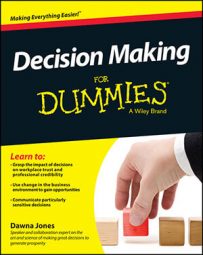Where order and structure are important to a company, employees are expected to follow established procedures. Such a “flight plan” clarifies who does what so that each team member knows his or her role and what to expect. These various factors — management style, working environment, authority structures, and so on — influence the dynamics of decision-making.
Factoring in management style and working environment
How things get done matters. Some organizations are hierarchical; that is, decisions, instructions, information, and so on, tend to flow from top to bottom. Other organizations have structures that tend to facilitate a freer flow of information; as a result, decisions tend to be more collaborative. Observing the path decisions follow within the organization increases awareness of how power is used. You can apply this knowledge to determine how best to proceed:
Hierarchical organizations: In hierarchical organizations, decisions typically flow downward, and decision-making authority is allocated and governed at each level. This is the command-and-control decision-making model.
In companies that focus attention on the bottom line (these companies typically have lower levels of self-awareness), a silo mentality is created. In a silo, functions are isolated and often compete with the rest of the organization, even at the expense of the company’s goals or customers’ satisfaction.
You can see this mentality at work when one department is unwilling to share information or expertise with another. Competition can be healthy, but not this kind.
Networked organizations: In networked organizations, information flows freely and is openly shared. Decisions tend to be made by consensus. A manager’s role isn’t to control or direct performance but to support teamwork by clearing the barriers that can stop work from getting done in order to achieve a common goal. Such an environment increases efficiency and supports collaboration.
The buck stops where? Authority and responsibility
In this context, the term authority refers to the position a person holds in the company and the decision-making power that goes with that position. The authority you have in your company determines how you to carry out your responsibilities, provide direction to others, take charge of a situation, or make decisions regarding allocation of resources.
Those with approval authority sign contracts and can commit the company to a financial or strategic direction. Approval authority is where the buck stops, so to speak.
The term responsibility refers to the legal and moral duty to perform a task to completion, and it points to the person who faces the music if the task fails. Collective responsibility relates to the performance of a group, regardless of individual contributions.
The kind of responsibility and authority that fall on your shoulders depends in large part on the structure of your organization:
Self-organizing or flat companies: In self-managed or “bossless” organizations, the management tier is missing. Each person plays a management role. Responsibility and authority are pushed out to all employees. Everyone is accountable and holds the authority, although some companies may assign specific areas of responsibility to someone with greater aptitude or experience.
The responsibility of overseeing the financial health of the company may fall to one of the partners who happens to be stronger in financial expertise, for example. Work is focused on achieving the goals of the company and getting the work done instead of managing the people.
Hierarchical organizations: Hierarchical companies are often associated with top-down authority. Hierarchies exist without use of authority to wield power, but for the most part, executives, managers, and supervisors (management tiers) hold authority and responsibility unless decision-making is decentralized.
Some organizations centralize all decision-making authority, which has the effect of making the approval process time-consuming. In others, decision-making is decentralized, so the company is more agile and able to respond to emerging conditions.
If you know how your company is organized and how authority and responsibility flow, you know how to move decisions through the organization. Companies using hierarchical, authority-based decision-making are structured around organizing working relationships. The difference in focus makes a big difference as to how powerful a company becomes.

